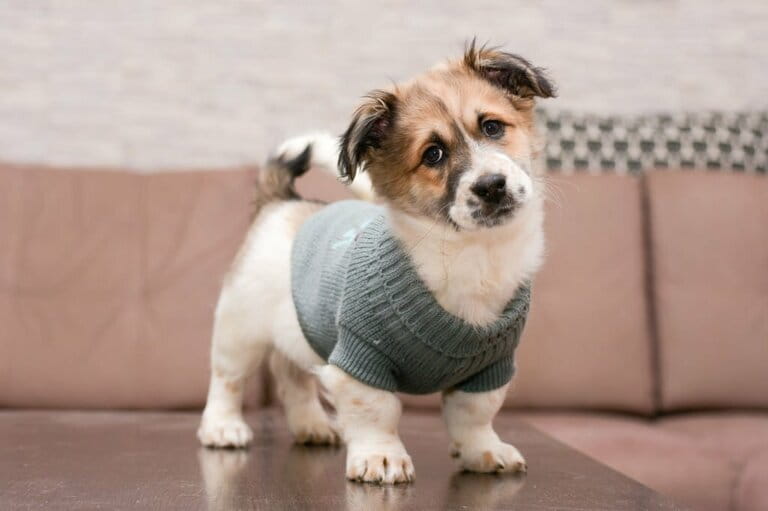Small dogs, like Chihuahuas and Yorkshire Terriers, often feel cold more easily than larger breeds. Their tiny bodies lose heat rapidly, making sweaters a useful way to keep them warm and comfortable. But are dog sweaters really a good idea for small breeds? Here's an in-depth look at the pros and cons.
Benefits of Sweaters for Small Dogs
Insulation Against Cold

- Small dogs have less body fat and muscle to generate warmth. Sweaters act as insulation to retain body heat.
- They prevent loss of core temperature when outdoors in cold weather or air-conditioned environments.
- Materials like wool or fleece trap warm air close to the skin to maintain a cozy temperature.
Protection From Wind, Rain, and Snow
- Sweaters shield small dogs from wet weather that can penetrate to the skin and chill them.
- Windproof fabrics provide a barrier against biting winds that steal away body heat.
- Getting wet in frigid conditions can quickly lead to hypothermia in tiny breeds.
Post-Grooming Warmth

- Having the coat clipped short for grooming leaves the skin exposed.
- Wearing a sweater prevents shivering and preserves comfort after grooming.
- It allows small dogs to remain fashionable with short "puppy cuts" year-round.
Cuteness and Style
- Sweaters come in endless colors and patterns to show off your dog's personality.
- Choices range from practical to playful designs with cute embellishments.
- They keep your small dog looking on-trend during cooler weather.
Anxiety Relief

- The gentle pressure of a well-fitted sweater can have a calming effect.
- This provides comfort to anxious or stressed dogs.
- The security and warmth help create a sense of safety.
Drawbacks of Doggie Sweaters
Restricted Movement
- Sweaters that are too tight or heavy may limit mobility.
- They could interfere with activities if not properly designed and fitted.
- Very active small dogs may resist wearing sweaters that impede their movement.
Overheating Risks

- Sweaters made from materials that don't breathe well have the potential to cause overheating.
- Wearing one indoors or on a mild day could lead to excessive warmth.
- Dogs can't remove sweaters themselves, so owners must supervise.
Skin Irritation
- Wool or rough-textured fabrics directly against the skin may create irritation.
- Sweaters must be washed frequently and kept clean to prevent skin problems.
- Hair loss, rashes, and hot spots are possible if sweaters don't fit right.
Hassle of Wearing

- It takes time and patience to teach dogs to tolerate wearing sweaters.
- They may resist or try to remove them if the fit is uncomfortable.
- Proper training is needed to avoid struggles each time you put one on.
Cost
- Designer dog sweaters can be quite pricey, especially for tiny sizes.
- Less expensive versions may be poorly constructed or made of subpar materials.
- Owners of multiple small dogs need to buy one for each, which adds up.
Tips for Using Sweaters Safely
Choose Proper Sizing
- Measure your dog's chest and length to select a size that's form-fitting but not tight.
- Allow room for insulated layers underneath if needed on cold days.
- Abrupt tapering from chest to abdomen can restrict movement and breathing.

Prioritize Quality Materials
- Seek natural fibers like merino wool or cashmere that insulate without overheating.
- Avoid low-quality synthetics that could irritate sensitive skin or cause static cling.
Monitor for Overheating
- Start with shorter sweater-wearing periods to check your dog's comfort level.
- Watch for signs of overheating like panting, agitation, or trying to remove it.
- Supervise outdoor sweater wear to ensure it comes off as activity increases.
Remove at Night

- Never leave sweaters on 24/7 or when unsupervised, as dogs can get caught on them.
- Take it off at night so your dog can self-regulate body temperature while sleeping.
- Check for any skin irritation, matting, or reactions daily when removing.
Maintain Proper Hygiene
- Hand wash or machine wash delicate dog sweaters frequently.
- Keep sweaters clean and free of dirt, dander, or parasites that irritate skin.
- Don't wait for sweaters to look or smell dirty, as they touch the skin directly.
- Air dry flat or tumble dry on low to prevent shrinkage.
Frequently Asked Questions
Are dog sweaters safe for puppies and senior dogs?
Both puppies and senior dogs benefit greatly from the extra warmth. But be vigilant about monitoring fit. Growing puppies will outgrow sweaters quickly. Arthritic senior dogs may need adaptive designs to avoid restricting movement.
What fabrics work best?
Merino wool and cashmere blend the warmth of wool with softness. Polyester microfleece provides affordable insulation. Water-resistant nylon or polyester blends add weather protection. Avoid low-quality acrylics.
Should the sweater be tight or loose?
The ideal fit hugs the torso without constriction and allows free head motion. Ample chest room is important, as breathing restriction is dangerous. But excess fabric can catch or twist. Use measurements for a customized fit.
How do I get my dog comfortable wearing a sweater?
Associate sweaters with praise and treats from an early age. Start with very short wear sessions, gently praising cooperation. Slowly increase sweater time as your dog seems comfortable. Never force into position or scold resistance. Remain positive.
Can dogs wear human sweaters or baby clothes?
It's risky. Human sweaters have openings, seams and fabrics that may encourage chewing, catch on objects, or irritate skin. While cute for photos, avoid leaving dogs unsupervised in modified human clothing. Well-designed dog sweaters are safer.
Conclusion
For tiny dogs prone to feeling cold, high-quality sweaters provide handy insulation against frigid weather and air conditioning. But owners must choose proper fit, materials, and precautions to keep dogs safe and comfy in their stylish outfits. With some training and vigilance against overheating or other risks, sweaters can be a wardrobe staple to help small dogs stay happily toasty when temperatures drop.













